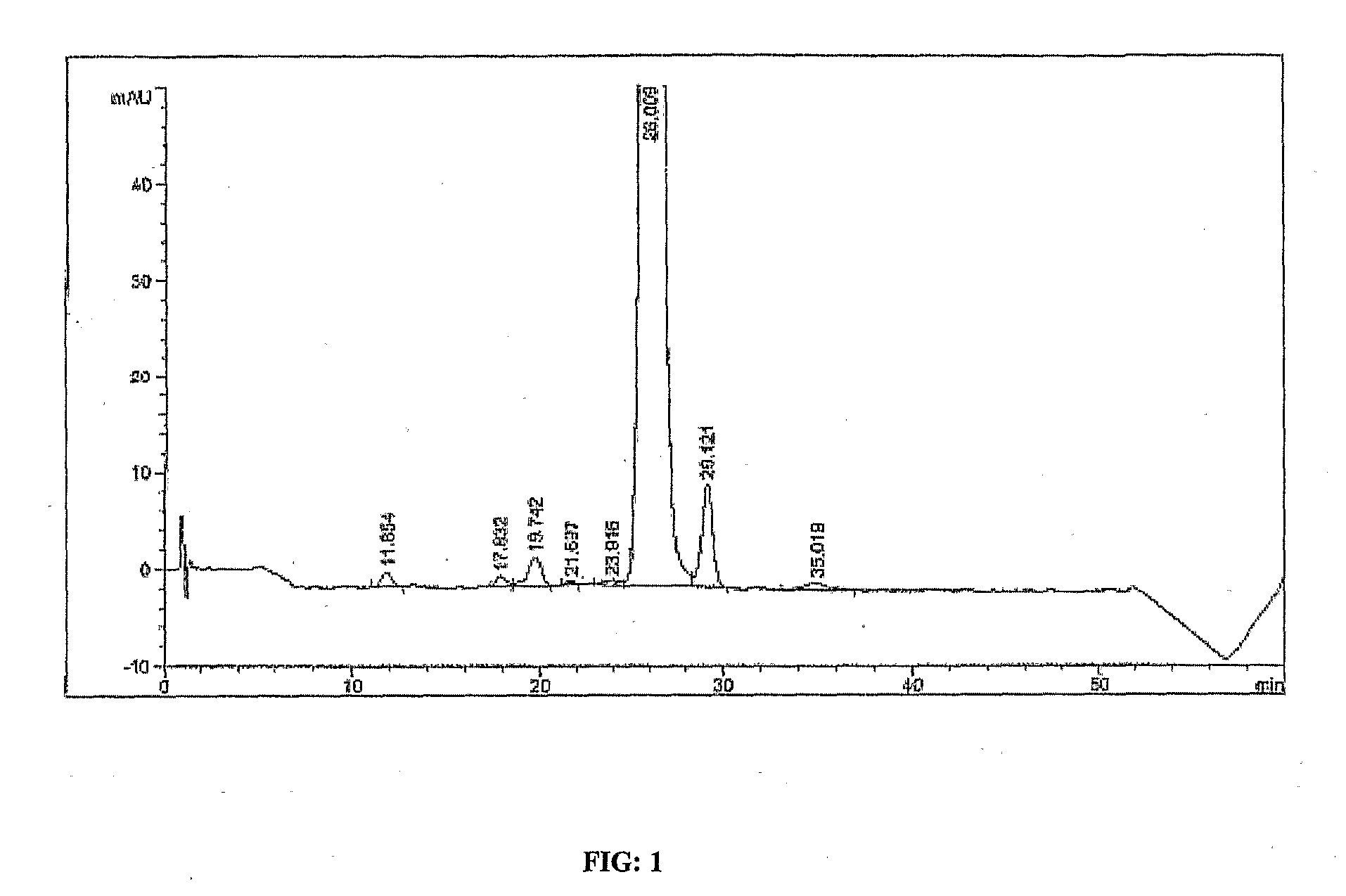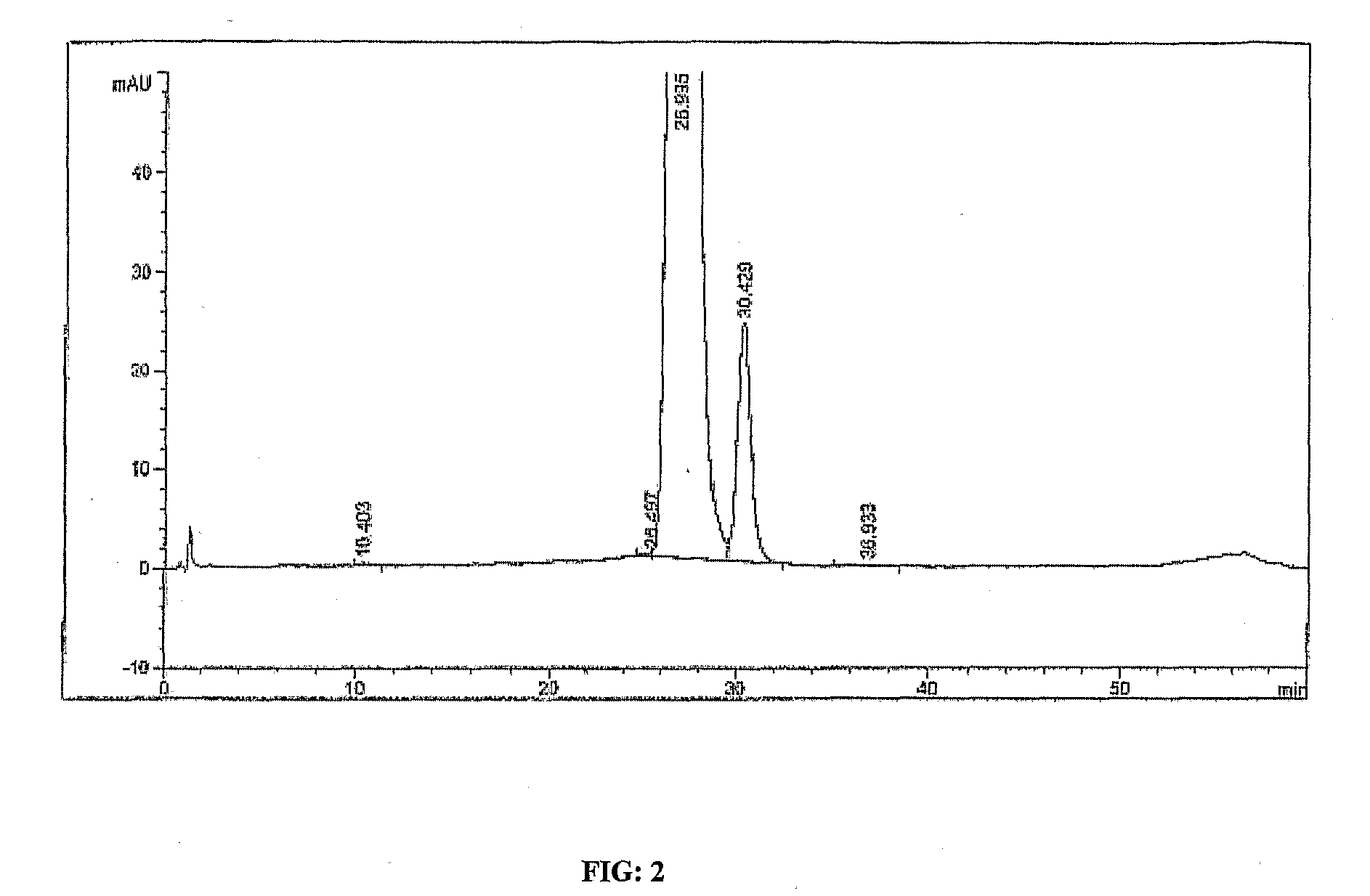Pure form of rapamycin and a process for recovery and purification thereof
a technology of rapamycin and purification process, which is applied in the field of rapamycin in the sub-prime form and the purification process thereof, can solve the problems of tedious methods for recovering macrolide compounds
- Summary
- Abstract
- Description
- Claims
- Application Information
AI Technical Summary
Benefits of technology
Problems solved by technology
Method used
Image
Examples
example 1
Recovery of Rapamycin
[0072]The fermentation broth (11 Kg) containing rapamycin was twice extracted with 11 L of ethyl acetate. The ethyl acetate extract was concentrated to obtain 206 g of oily residue. The residue was extracted thrice with 600 ml of acetonitrile. The acetonitrile extracts were concentrated to obtain 90 g of oily residue. The residue was mixed with 1 L of ethyl acetate. 500 g of diatomaceous earth was added to this solution. The solution was concentrated completely. The concentrate was slurried in 1 L of 0.01 M sodium bicarbonate solution in water. The mixture was filtered. The filtered solids were further washed with 9 L of 0.01 M sodium bicarbonate solution. The base wash was followed by 10 L of 0.1 N aqueous hydrochloric acid solution. The solids were then washed with water. The product was eluted using ethyl acetate. The elute was concentrated to obtain 56 g of residue.
[0073]The residue was applied to a column packed with silica gel. The column was washed with 1...
example 2
Recovery of Rapamycin
[0074]The fermentation broth (2500 Kg) containing rapamycin was extracted with ethyl acetate (three extractions in the ratio of 1:0.5, 1:0.25, 1:0.25). The ethyl acetate extract was concentrated to about 1000 Kg. The partially concentrated ethyl acetate layer was washed with water. The ethyl acetate layer was concentrated to obtain 50 Kg of oily residue. The residue was extracted thrice with 150 Kg of acetonitrile. The acetonitrile extracts were concentrated to obtain 11 Kg of oily residue. The residue was mixed with 200 Kg of ethyl acetate. 0.765 Kg of activated charcoal was added to this solution. The solution was stirred and filtered. The filtrate was concentrated completely to obtain residue.
[0075]The residue was applied to a column packed with silica gel. The column was washed with 15% acetone in hexane and 25% acetone in hexane. The product was eluted with 40% acetone in hexane. The product containing fractions were concentrated to obtain oily residue. The...
example 3
Purification of Rapamycin
[0076]3 g of powder obtained in Example 1 was dissolved in 90 ml of acetonitrile. The solution was concentrated and kept at 4° C. for crystallization. The crystals were filtered and dried. 2.5 g of white crystals were obtained. The total impurities in these crystals were 0.5% and the impurity at RRT 1.34 was 0.25%.
PUM
| Property | Measurement | Unit |
|---|---|---|
| mass 14 | aaaaa | aaaaa |
| volume | aaaaa | aaaaa |
| concentration | aaaaa | aaaaa |
Abstract
Description
Claims
Application Information
 Login to View More
Login to View More - R&D
- Intellectual Property
- Life Sciences
- Materials
- Tech Scout
- Unparalleled Data Quality
- Higher Quality Content
- 60% Fewer Hallucinations
Browse by: Latest US Patents, China's latest patents, Technical Efficacy Thesaurus, Application Domain, Technology Topic, Popular Technical Reports.
© 2025 PatSnap. All rights reserved.Legal|Privacy policy|Modern Slavery Act Transparency Statement|Sitemap|About US| Contact US: help@patsnap.com


